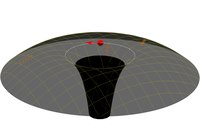
Photo from wikipedia
Gamma-ray bursts (GRBs) are the strongest explosions in the Universe since the Big Bang. They are believed to be produced either in the formation of black holes at the end… Click to show full abstract
Gamma-ray bursts (GRBs) are the strongest explosions in the Universe since the Big Bang. They are believed to be produced either in the formation of black holes at the end of massive star evolution1–3 or the merging of compact objects4. Spectral and timing properties of GRBs suggest that the observed bright gamma-rays are produced in the most relativistic jets in the Universe4; however, the physical properties (especially the structure and magnetic topologies) of the jets are still not well known, despite several decades of studies. It is widely believed that precise measurements of the polarization properties of GRBs should provide crucial information on the highly relativistic jets5. As a result, there have been many reports of GRB polarization measurements with diverse results (see ref. 6); however, many such measurements suffer from substantial uncertainties, most of which are systematic (ref. 7 and the references therein). After the first successful measurements by the Gamma-Ray Burst Polarimeter (GAP) and Compton Spectrometer and Imager (COSI) instruments8–10, here we report a statistically meaningful sample of precise polarization measurements, obtained with the dedicated GRB polarimeter POLAR onboard China’s Tiangong-2 space laboratory. Our results suggest that the gamma-ray emission is at most polarized at a level lower than some popular models have predicted, although our results also show intrapulse evolution of the polarization angle. This indicates that the low polarization degrees could be due to an evolving polarization angle during a GRB.Precise polarization measurements from the gamma-ray burst polarimeter POLAR suggest that the gamma-ray emission is at most polarized at a level lower than predicted by some models and also shows intrapulse evolution of its polarization angle.
Journal Title: Nature Astronomy
Year Published: 2019
Link to full text (if available)
Share on Social Media: Sign Up to like & get
recommendations!